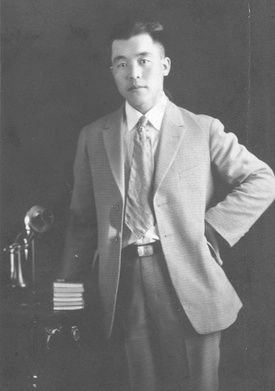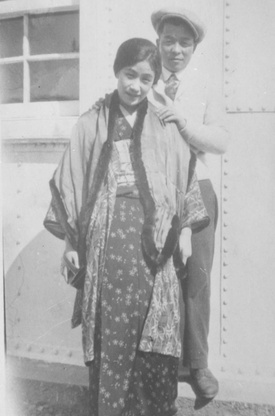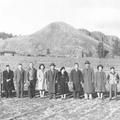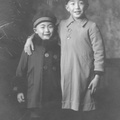Foreword by Phyllis Parham Reeve
We came to Page’s Resort & Marina on Silva Bay, Gabriola Island, in 1987, eager to carry on the spirit of the place as established by the Page brothers, Les and Jack, and their families. As we learned from them the story of the Bay, the docks, the fishermen and the shore people, we heard that before Page's Store, fishing camp and marina, there had been Koyama's Fishing Camp, with docks, a store, and sometimes a family. The Pages had known Kanshiro Koyama, fishing and trading in the same waters for years until the traumatic events of the war years, and his forced disappearance from the Coast. No one seemed to know what had become of him, except that he had not returned to Silva Bay, even after 1949 when some Japanese fisherman did resume their lives in Nanaimo and Steveston.
I found occasional mention of him, especially when reading Masako Fukawa's books about the Nikkei fishing fleet1, but nothing postwar. Fukawa's grandfather had been one of the proprietors of the Sunrise Saw mill, also in Silva Bay. The Gabriola Historical and Museum Society became interested, and in 2011 I put together a piece about "The Japanese-Canadians of Silva Bay 1918-1942" for the Museum's journal Shale, now sadly defunct.2 In 2017, the two Silva Bay locations were designated Japanese Canadian historic sites.3 They are part of Gabriola's story. But the Koyama story has been incomplete...
... Until December 2020, when out of the blue I received a phone call from Daniel "Yosh" Koyama, son of Kanshiro. Now an octogenarian (like myself) and a resident of California, he and his son Tim had found the Museum's stories on the internet, and were eager to tell his father's story. To my delight, he was as excited to find out what had happened to the Fishing Camp over the years as I was to find out what had happened to his family.
Numerous phone calls and emails later, we have the story. In fact, we have two stories: the story of a decent, hard-working man whose world was smashed; and the story of his son who confronted prejudice in both Japan and America.
* * * * *
The story as told by Daniel "Yosh" Koyama
1898-1941
Kanshiro Koyama was born in 1898 in Mio-mura, a tiny village in Japan's southwestern prefecture of Wakayama, the fourth boy among seven children of Tomekichi Koyama. There was little arable land and no big fishing area, and by the time Kanshiro reached his teens, almost 70% of the townspeople had emigrated to North America. Emigrants reported back to the village about the plentiful fish. With the money sent to Mio, villagers built western-style homes and adopted other trappings of western society, and the village became known as "Amerika-mura".4
So he joined others, including his own siblings in the area around Vancouver Island, especially Nanaimo, where his brother Frank had a successful fishing camp in the Brechin area5, and later Gabriola Island. Kanshiro fished the whole area that encompasses Prince Rupert all through the inland sea and the Strait of Georgia, West and South Coast. While fishing, he set out to buy out their catches from other fishermen and transport these to Vancouver Wholesale Markets and canneries. And that’s how he became at the same time one of the Nikkei Canadian fishermen and the proprietor of the fish camp in Silva Bay.
He was held in high regard by his Caucasian friends/peers and families. Kanshiro Koyama’s small stature of 5’2” belied his strength. He always had a contagious smile and an eagerness to help others. He would have known the Page family, fishermen based on Galiano Island.
On one of his regular return visits to Japan, he married Haruko Shima, who accompanied him back to Canada, not knowing what conditions awaited her in British Columbia. The daughter of a Shinto priest, she had no idea how to care for her first baby boy Tetsuo, who was born on Gabriola Island in about 1928. Tetsuo died in infancy, from beriberi, or Vitamin B deficiency, an illness readily treated with proper information and medical care, neither of which was available.
And so Kanshiro sent his wife back to Japan and divided his life between his family and his livelihood, with the Pacific Ocean between them. Haruko was not all that healthy herself and she had to care for a very frail mother, in addition to taking care of the two sons she gave birth to in Japan, Kazu and Yosh.
Nevertheless, Haruko and Kanshiro were far from poor. Dad was making a good living in those days fishing the BC Coast and operating the Koyama Fish Camp and he sent money through Yokohama Exchange Bank so Mom could make a rich lifestyle in an exclusive part of Wakayama City adjacent to the Castle. Dad used to come visit us almost every year and I have a recollection of a big ship and Christmas presents by my bed. Other than that I didn’t have vivid memories of my Dad until after the end of war when he came back in a Canadian government ‘repatriation’ ship in 1947.
I am the writer of my Dad’s story and years after his death, I get testimonies from his now aging nieces and nephews and from old family friends and relatives about how “Kanshian” was so good to them and so respected. His love of all children stemmed from the fact that his own two children were growing up in the distant land of Japan and every child reminded him of that.
December 7, 1941
Then war came and his world turned upside down. The Canadian government confiscated his boat without compensation and gave him 72 hours to get rid of his personal belongings.
Instead of waiting with others to be rounded up like cattle and forced into an internment camp, my Dad took the best course of action. He went on his own volition, looked up friends in Kamloops, BC. and relocated more than 100 miles from the British Columbia Coast.
After almost a lifetime as a Nikkei fisherman, he must turn himself into a farmer. But Kanshiro Koyama was resilient, stayed calm and adaptable and tried to do his best. His love for his family during the isolation of war and his concerns for his family’s safety intensified as the tide of war turned against Japan.
But he kept his faith. Every morning and night he turned to the West and must have said thousands of prayers: "please spare my family from the bombing and ravages of war and please watch over them."
Married to the daughter of a Shinto priest and brought up a Buddhist, he had a myriad of different prayers and he said them all, not to just one god but to gods of all faiths, while two of his children and his frail mother with chronic thyroid disorder were being pushed to the edges of annihilation.
Koyama's Fish Camp in Silva Bay belonged now, and for the next 44 years, to Les and Jack Page, who would expand the store and the docks until it gradually became Page's Resort and Marina. Kanshiro knew and liked the Page Brothers, but he no longer had a home on the Coast.
Notes:
1. Masako Fukawa et al. Nikkei Fishermen of the BC Coast, Harbour Publishing, 2007. Spirit of the Nikkei Fleet, Harbour Publishing, 2009,
2. Phyllis Reeve, "The Japanese-Canadians of Silva Bay," SHALE 25, pp.3–8, March 2011.
3. Gabriola Museum and Historical Society, "Gabriola locations among Heritage BC’s newly designated Japanese-Canadian historic sites."
4. Chuck Tasaka, "Mio-Steveston Fishermen Dialect," The Bulletin: a Journal of Japanese Canadian community, History + Culture, January 8, 2017.
5. "Frank Koyama obituary March 3 1944," Nanaim Free Press, March 4 1944.
*This article, written by Daniel “Yosh” Koyama with Timothy Koyama and Phyllis Reeve, was originally published in the Nikkei Images, Vol 26, No. 1.
© 2021 Daniel "Yosh" Koyama









